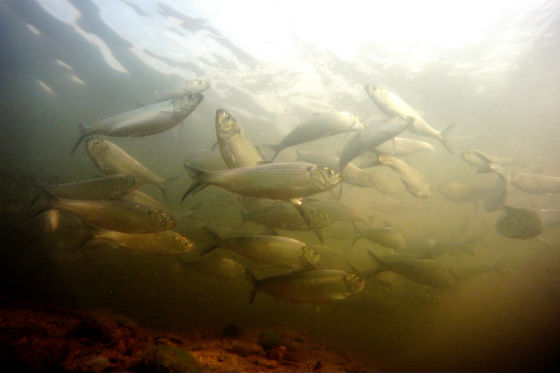Local Scientists Document Large Increase of Herring at Mystic Lakes Dam

Since 2012, the Mystic River Watershed Association (MyRWA) has been working with hundreds of volunteers to count river herring passing through the fish ladder at Mystic Lakes Dam to spawn in Upper Mystic Lake. In 2015, the citizen scientists were able to document that an estimated nearly half a million river herring swam through the fish ladder to spawn – a 100% increase over the counts in the previous three years.
River herring collectively refer to two species of herring, Blueback (Alosa aestivilis) and Alewife (Alosa pseudoharengus). These two species are referred to as “anadromous†fish as they live the majority of their life in salt water but lay eggs (spawn) in fresh water. The billions of river herring eggs that are produced in Upper Mystic Lake will develop into juvenile herring within just a few days. These juveniles will stay in the fresh water for up to 4 months before swimming downstream to live in estuarine waters. The river herring that survive will reach an age to reproduce after 3-4 years and usually return to the same waters where they were born.
The Mystic River is one of 78 river herring runs in Massachusetts. River herring are an important component of ocean fisheries, and they need access to freshwater systems to survive. Over the past several decades, populations of river herring have dramatically declined.
The Mystic River Watershed Association works each year to train a set of volunteers to perform visual counts at the fish ladder Mystic Lakes Dam. The volunteers agree to perform at least one 10-minute observation each week. Volunteers in the 2015 program performed 680 ten minute observations and counted 57,617 fish. The observations and counted fish are plugged into a sophisticated model developed by the Division of Marine Fisheries that yields the population estimate of 477,827 +/- 40,674 for 2015.
The Massachusetts Division of Marine Fisheries released a statement on the outcome of the 2015 Mystic Count:
“The Division of Marine Fisheries is very pleased to see the excellent return of river herring to the Mystic River this year. The large increase in returning herring gives us confidence that the restoration of access to Upper Mystic Lake has benefited this population. The Mystic River is now one of the largest runs in the Commonwealth and even more so as it has both alewife and blueback herring in the run. The Mystic River Watershed Association has done an excellent job coordinating a very well run volunteer count and acting as stewards of the river. Information about the abundance of herring complements the biological sampling DMF does on the river and also provides context about Boston Harbor runs in the context of a statewide monitoring effort led by DMF. We look forward to working with MyRWA, DCR, and all other partners to benefit river herring and other diadromous fishes in the Mystic and Aberjona watersheds.”
The question that is on everybody’s mind is “What is the explanation for the dramatic increase in the number of fish observed in 2015?†The Mystic River Watershed Association and the Massachusetts Division of Marine Fisheries (MA-DMF) are exploring this question. One explanation might be that since large numbers of river herring were not able to access the additional habitat in Upper Mystic Lake before 2011 when the new dam and fish ladder were completed, we might be witnessing a true increase in the adult population that results from providing additional quality habitat for spawning. The fish count in 2016 will contribute to an understanding of this year’s numbers. If the numbers stay high, it may be evidence that the population has increased in a sustainable way.
“The scale of this herring migration shows the Mystic River to be a living, breathing ecosystem, filled with life,” says MyRWA Executive Director, EkOngKar Singh Khalsa. “It may be hard to see that life from Interstate I-93, and it is easy to take this urban river for granted. But the herring run speaks to the importance of treating natural spaces in urban areas with great respect and care. We can live alongside nature, if we are thoughtful.”
Work is underway to build upon the successes of the 2012-2015 counting programs. MyRWA is working with MA-DMF and local river herring advocates to see a fish ladder installed at the Center Falls Dam in Winchester center to allow herring access to Wedge Pond and potentially Horn Pond. MyRWA is working with local municipalities to identify opportunities to improve habitat and water quality throughout the watershed.
The Mystic River Watershed is a vital natural resource for the more than 500,000 people who live in 22 Mystic River communities. For more information about the Mystic River Watershed Association please see www.MysticRiver.org.
– Submitted by Mystic River Watershed Association